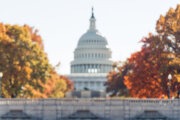There are two big developments on the U.S. national health care stage, one well-publicized and the other flying somewhat under the radar.
The obvious story is the Affordable Care Act debate under way in the U.S. Senate, where Congressional Republicans are still a few votes shy of passing their own health care bill, the American Health Care Act (which looks suspiciously similar to the old health care bill).
[Read: How to Invest in Health Care in a Trump Presidency.]
The second issue is a new study — HealthView’s 2017 Retirement Health Care Costs Data Report — that shows the total cost of health care in retirement for a 65-year-old couple cresting $400,000.
Both stories are intertwined, and investors of health care stocks and funds should keep these developments in mind.
“The $404,000 is a very realistic, perhaps even conservative, figure,” states Rob Drury, executive director of the Association of Christian Financial Advisors in San Antonio, Texas.
Drury says the HealthView study includes long-term care costs in its estimate. More than 70 percent of retirees will need long-term care at an expected cost currently exceeding $200,000. Assuming there are two retirees in most households, long-term care accounts for the lion’s share of HealthView’s figure, he says.
The issue remains up in the air in the health care debate, industry insiders say. And that doesn’t help investors interested in health care exchange-traded funds.
“The AHCA debate is far from settled,” says C.J. Brott, chairman of Capital Ideas in Dallas. “As a result, broad-based health ETFs such as Health Care Select Sector SPDR ETF (ticker: XLV) are too dicey to buy now.” In addition, owning any hospital-oriented stocks and funds is also a questionable proposition, given that sector likely “loses out,” according to Brott. “The same goes for health insurance companies whose outlook is cloudy and device makers, as well,” he says. “Both seem to water down any future health care investing returns.”
Brott remains bullish, however, on the pharmaceutical industry as a whole. “I am essentially invested in one area of it, biotech,” he says. “The best biotech investments have been the SPDR S&P Biotech ETF ( XBI) and two Bioshares ETFs – BioShares Biotechnology Clinical Trials ( BBC) and BioShares Biotechnology Products ( BBP). Each of these funds are pure plays on biotech,” he says. “I’m not exposing myself to other less desirable areas of the health care sector.”
Brott says he owns XBI because it’s broad-based and equal-weighted, giving him the exposure to up-and-coming smaller companies, where the innovation breakthroughs and subsequent acquisitions are concentrated.
“For purposes of expert selection, I own the Bioshares ETFs,” he adds. “I still get diversification, but it is informed selection by the Bioshares experts. So far, they’ve demonstrated above-average knowledge of the industry, and have been invested in some of the biggest up-and-comer companies.”
Brott also likes biotech, as the buzz surrounding the AHCA bill seems favorable for breakthrough therapies. “I believe the high prices for biotechs are justified,” he notes. “Biopharm firms should be allowed to recoup their investments and make good profits,” he adds. “Although I own a few specific pharmaceutical companies, I intend to continue concentrating on biotech.”
[See: 9 Biotech Stock Funds to Buy.]
Longer term, any new health care bill that addresses the industry’s onerous regulations should boost the sector’s stocks and funds.
“The plan to replace Obamacare has the promise of rolling back growth-stopping regulations,” says Ron Kloth, a wealth manager with Dynamic Wealth Advisors in Tempe, Arizona. “Whether that happens now or down the road leads one to see some future gains in the health care market segment.”
That’s especially so with an aging population, where the demand for health care products and services is rising globally, he notes. “Many companies in the health care segment are flush with cash, which sets up a scenario for higher dividends or stock buybacks, which make them ‘value’ opportunities for long-term appreciation,” Kloth says. “While the health care market is subject to short-term swings based on the ‘noise’ of what is coming out of Washington, the fundamentals of many stocks in this area are sound.”
Kloth believes that industry-specific ETFs are a good way to supplement your returns in a diversified portfolio, both now and down the road. “I like four health care ETFs,” Kloth says. “The first two, Vanguard Healthcare ( VHT) and Fidelity MSCI Healthcare ( FHLC), offer the most diversification by holding many different holdings, and have similar expense ratios and returns.”
Each ETF has more than 340 individual holdings and boasts impressive financials, he adds. “VHT’s expense ratio is 0.10 percent and has a year-to-date return of 18.73 percent, while FHLC’s expense ratio is 0.08 percent and has a year-to-date return of 18.34 percent.
Kloth’s other picks include Global X Longevity Thematic ETF ( LNGR) and iShares U.S. Medical Devices ETF ( IHI). “Like my first two fund picks, the expense ratios and returns for both funds are similar to each other,” he says. “LNGR’s expense ratio is 0.50 percent with a year-to-date return of 24.98 percent, while IHI’s expense ratio is 0.44 percent with a 25.76 percent year-to-date return. The broader-based ETFs are better for those who seek greater diversification and smoother returns over time, versus the more specific funds which will have more volatility but offer the potential for larger returns [or losses].”
For a buffer against U.S.-only companies, health care industry observers advise heading overseas.
“Most of the health care ETFs trading in the U.S. invest along the following categories — U.S. biotech, U.S. health care, U.S. pharmaceuticals, U.S. health care providers and services, and U.S. health care equipment and supplies,” says Elias Azrak, president of ETFx Investment Partners and creator of the ETFx Healthtech Index. “This makes the PureFunds ETFx HealthTech ETF ( IMED) a rare exception, having a global portfolio with approximately only half of the constituents U.S. companies. “The remaining companies are 30 percent European and 20 percent Asian.”
There’s no shortage of uncertainty — and angst — hovering over the U.S. health care sector. But overall, the prognosis seems OK for most industry stocks and funds.
“The health care sector depends very heavily on the outcome of how the ACA will be modified [if at all] and when such modifications will be known and be put into effect,” says Sridhar Tayur, professor of operations management at the Tepper School of Business at Carnegie Mellon University. “However, much of the uncertainty is already priced into these stocks and also in the funds that hold them.”
[See: 7 of the Best Health Care Stocks to Buy for 2017.]
The overall reduction in uncertainty for how the health care debate gets resolved, “will be good in its own right,” he says. “When that occurs, I expect all boats to rise.”
More from U.S. News
13 Ways to Take the Emotions Out of Investing
The Best ETFs Retirees Can Buy
The Fastest Ways to Lose All Your Money in the Stock Market
The Cure for Anxious Health Care Investors originally appeared on usnews.com







